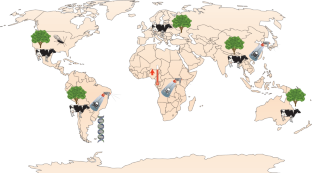An international team of authors present a horizon scan of the predominant causes and consequences of pollinator loss, revealing that perceptions of the risks of losing pollinators vary substantially among regions.

References
Adams, W. M. et al. Science 306, 1146–1149 (2004).
Klein, A. M. et al. Proc. R. Soc. B 274, 303–313 (2007).
Potts, S. G. et al. Trends Ecol. Evol. 25, 345–353 (2010).
Aizen, M. A. et al. Global Change Biol. 25, 3516–3527 (2019).
Dicks, L. V. et al. Nat. Ecol. Evol. https://doi.org/10.1038/s41559-021-01534-9 (2021).
Mazor, T. et al. Nat. Ecol. Evol. 2, 1071–1074 (2018).
Brittain, C. A., Vighi, M., Bommarco, R., Settele, J. & Potts, S. G. Basic Appl. Ecol. 11, 106–115 (2010).
Roubik, D. W. Pollinator Safety in Agriculture (Food and Agricultural Organisation of the United Nations, 2014).
Ecobichon, D. J. Toxicology 160, 27–33 (2001).
Ravindranath, N. H. & Sathaye, J. A. In Climate Change and Developing Countries 247–265 (Springer, 2002).
The Assessment Report of the Intergovernmental Science-Policy Platform on Biodiversity and Ecosystem Services on Pollinators, Pollination and Food Production (eds Potts, S. G. et al.) (IPBES, 2016).
Summary for Policymakers of the Assessment Report of the Intergovernmental Science-Policy Platform On Biodiversity and Ecosystem Services on Pollinators, Pollination and Food Production (eds Potts, S. G. et al.) (IPBES, 2016).
Acknowledgements
Support for this work on pollinators was provided by Princeton University and the Whitley Fund for Nature.
Author information
Authors and Affiliations
Corresponding author
Ethics declarations
Competing interests
The author declares no competing interests.
Rights and permissions
About this article
Cite this article
Martins, D.J. Best practice for protecting pollinators. Nat Ecol Evol 5, 1336–1337 (2021). https://doi.org/10.1038/s41559-021-01531-y
Published:
Issue Date:
DOI: https://doi.org/10.1038/s41559-021-01531-y
- Springer Nature Limited


